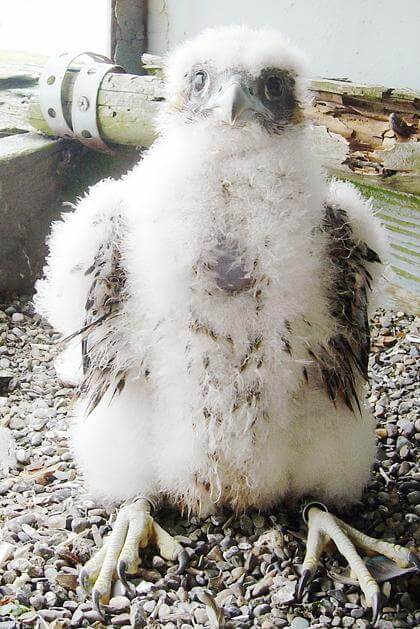By Philip Newman
With the approach of summer, five Peregrine falcon chicks have been born in lofty aeries on some of the city’s highest bridge towers.
The MTA Bridges and Tunnels Department said three chicks were recently born on the Verrazano−Narrows Bridge, one on the Throgs Neck Bridge and one on the Marine Parkway−Gil Hodges Memorial Bridge.
It is an annual event this time of year.
The Peregrine falcon is listed as an endangered species in the state, although not by federal wildlife authorities.
State wildlife personnel placed metal bands on the chicks last week, which will enable authorities to track them as they grow and reproduce.
The Verrazano−Narrows falcons included two females and a male, while the Throgs Neck and Marine Parkway−Gil Hodges birds were both males.
Bridges and Tunnels officials said the Throgs Neck chick was four weeks old when it was banded and the others were three weeks old.
“We have a good relationship with the falcons because we’re like absentee landlords,” said Ray Higgins, maintenance superintendent of the Throgs Neck Bridge. “We set them up with a nice place to live and then try not to bother them.”
The falcons’ original box nest was beneath the lower level roadway of the Verrazano until 2000, when a paint project was begun and containment shrouds were put up.
“We did not want the falcons to leave altogether, so we built one box atop the Brooklyn tower and another atop the Brooklyn pedestal and gave them a choice,” Verrazano Maintenance Supervisor William McCann said. “The falcons chose the tower with its sweeping view of New York Bay from 693 feet above the water and they have returned each mating season.”
The falcons’ nest on the Throgs Neck is 360 feet high.
The falcons like high points, including church steeples and high−rise buildings, because they provide an excellent vantage point for hunting prey, including pigeons and small birds.
In 2008, the state Department of Environmental Conservation documented 67 pairs of Peregrine falcons living in the city.
The Marine Parkway−Gil Hodges Bridge has the most historical nesting place. The nesting box, located 215 feet above the water on the Rockaway side of the bridge, is inside an old gun turret installed during World War II.
Rockaway Maintenance Superintendent Carlton Cyrus said the nest would “get an upgrade because the wood in the original box is badly splintered and is dangerous for the chicks.”
The young falcons will soon be leaving their nests.
At three weeks old, their talons are the size of a an adult human hand and they eat five times a day.
They will begin practice flying from atop the bridges in the next two to three weeks and will leave the nest for good by July.
Reach contributing writer Philip Newman by e−mail at timesledgernews@cnglocal.com or phone at 718−229−0300, Ext. 136.































